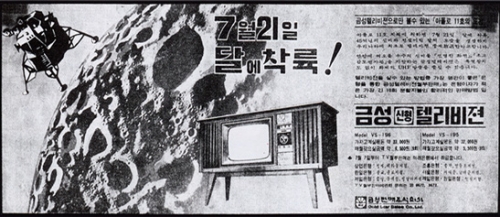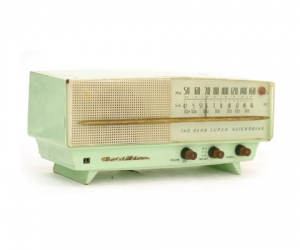“The Electronics Industry Is Born” – A Story of the 1950s

Electronics played the leading role in the development of human society and many industries in the 20th century. It was a new challenge, but opened a new vista for Korea’s fledgling economy in the late 1950s. It was the driving force for the economic development the country would achieve in later decades.
First Economic Plan
Korea’s first economic plan was worked out by the Syngman Rhee administration and the succeeding Chang Myon caretaker government in the 1950s. It focused on rehabilitating an economy devastated by the Korean War (1950-1953). Investments in the industry were directed to replace imports based on aid supplies from the United States.
Electricity Industry
Before Korea’s electronics industry got off to a promising start in the late 1950s, the electricity industry served various purposes for the people. In 1887, the Chosun royal court imported a 3KW steam powered generator and related facilities from Townsend Electric in the United States. In 1898, two American businessmen, Henry Collbran and Harry R. Bostwick, obtained the right to an electrical service business and founded Hansung Electric Company, the first electric power company in Korea, in Seoul. They installed a 125KW power generator on April 10, 1900, and began transmitting electricity to private homes in the Jongno area of the metropolis.
A large portion of the demand for electric appliances was met by imports from the United States and Japan at first. The first electric bulb plant was established by the Japanese in Busan in 1910. In 1917, Korean household subcontractors supplied Japanese firms with small electric bulbs for the first time. Korea's first electric bulb factory was founded in 1935 within their own capital.
After national liberation in 1945, no remarkable changes occurred in the economic sector. In 1953, when various kinds of economic statistics were compiled for the first time, Korea’s per capita GNP stood at a mere US$67. In such an adverse economic situation, almost all electric and electronic home appliances such as radios, TV sets, refrigerators, electric fans, and telephones were imported from Japan and the United States as luxury goods for a small minority of wealthy people. In a word, there was a near zero foundation for the electronics industry to spring to life and grow.
To make matters worse, North Korea, which had most of the power generation facilities for the entire Korean Peninsula at that time, cut power supply to South Korea in May 1948. As a result, South Korean people had to live off the country's own scanty electricity grid that could generate only 206,000 KW per year, a mere 14 percent of the entire demand in the South.
First Korean Electric Equipment Makers
After 1948, when the Ministry of Commerce and Industry formulated a bill to promote the electricity industry, many civilian Korean electric bulb, cable, battery, transformer, motor, and heavy electric equipment makers were established one after another. At that time, major companies founded by the Japanese colonialists had been taken over by the US military government, which, in turn, handed them over to the Ministry of Commerce and Industry. Then, the Ministry sold them to Korean businessmen who were determined to develop the fledgling industry.
The largest such company was Chosun Toshiba Electric, a motor and transformer maker, which was changed to Ichun Electric in 1950. Ichun Electric was sold to Samsung Electric, and was eventually merged into Iljin Heavy Industries. The other major companies followed similar processes.
First Korean Companies Founded with Their Own Investment
Honam Electric Industrial Co., the predecessor of Rocket Electric Co., was established in Gwangju in 1946 as the first Korean electric equipment company founded with its own investment. Several other companies followed suit, including Kunjunsa Co., a streetcar motor maker, Kukje Electric Co., a transformer maker and maintenance and repair service provider, and Hankwang Electric Co., a transformer maker.
In the wake of the Korean War, the electricity supply ratio dropped to about 20 percent and many electric industrial facilities were destroyed. But after the war, electricity facilities were restored during the late 1950s.
Electricity Industry in the 1950s

In the 1950s, the people welcomed the electricity industry as the state-of-the-art technological field that they believed would illuminate the future. But the industry suffered from lack of technology and engineers until the latter part of the decade. There were only a handful of primary-level technicians and skilled craftsmen rather than well-informed and experienced engineers.
There were production facilities the Japanese had left behind, but there were neither the capabilities nor technology to operate them. Another problem was the lack of sufficient materials. For example, iron plates were used instead of silicon steel plates for transformers or motors. As a result, many such devices were ruptured and naturally led to people’s distrust of domestically made electric appliances and equipment.
Technological Development Begins
In the late 1950s, Korean industrialists became determined to develop their own technologies with the help of the U.S. International Cooperation Administration. First of all, Ihwa Electric Engineering Co. developed the high-efficiency automatic voltage regulator in 1958.
As the leader of the industry, Ichun Electric, meanwhile, built a modernized production facility and stepped up efforts to develop its own technologies. Finally, in 1959, it succeeded in producing a 22KV transformer and a 370KV motor with its own technology, a first for Korea.
The efforts by such companies to develop their own technologies paved the way for the country’s electronics industry to emerge and grow afterwards.
Electronics Industry Is Born

Only in late 1957 was Korea restored to its pre-war state thanks to the Korean government’s determination and foreign aid. All these difficult times really were a hardship and ordeal for the country. But in this process, the Korean industrialists eventually learned to accumulate capital and develop their own technologies.
At long last, in June 1959 GoldStar (present-day LG Electronics) began developing Korea’s first vacuum tube AM radio – a five-vacuum tube, two-band superheterodyne radio. The first radio was modeled after the Sanyo radio of Japan. To build an assembly line, GoldStar imported production facilities worth US$250,000 from West Germany. Vacuum tubes were also imported from West Germany, but radio switches were developed by GoldStar’s engineers.
The radio had a capacity of 50 volts, given the poor reliability of electricity supply. It also had 2W speakers, and the radio cabinet was 178 by 429 by 163mm. Some 80 prototype radios were produced about three months later. Three more months passed before the “A-501” prototype radio was finally commercialized, with a crown-shape trademark logo embossed on the upper left side of the radio cabinet, signaling the birth of Korea’s electronics industry.
After the A-501 model was released, GoldStar developed as many as seven models the following year. The next model was the small and cheap A-401 model designed for students and children, and the third model was the B-401. The fourth model was TP-601, the country’s first portable transistor radio. Afterwards, deluxe and popular models, such as A-502, A-503, A-701, and A-702, were released to meet the increasing demand in the country.
Full Series Schedule
For those interested in past or future issues of this series, here isthe full schedule of the series:
July 2009: an overview
August 2009: The electronics industry is born
September 2009: Electronics industry gains momentum
October 2009: Color TV production opens a new vista
November 2009: Radios, cassettesand electronic watches change lifestyle
December 2009: The personal computer arrives
January 2010: TDX1 introduced into the local network
February 2010: TFT LCD allows determination of film thickness
March 2010: CDMA comes into commercial use
April 2010: U-technologies (part 1)
June 2010: U-technologies (part 2)
July/August 2010 : WiMAX opens
September 2010 : Era of IPTV


